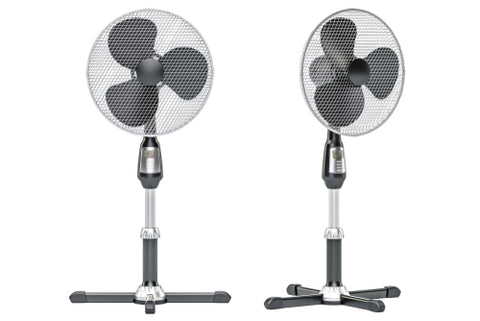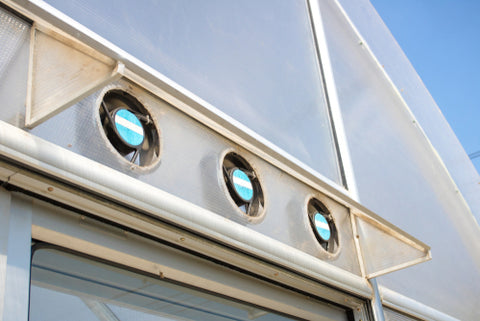
What Kind Of Ventilation Does Your Indoor Garden Need?
Indoor hydroponic systems allow you to have complete control over your garden’s growing conditions, enabling year-round yield in a convenient way. However, if you don’t properly maintain the right conditions in your grow tent, you can damage and kill your plants.
One of the most crucial, yet often overlooked, aspects of indoor gardening is ventilation. In an indoor environment, your plants aren’t getting the same sort of fresh air and light breezes that an outdoor plant might get. Quality ventilation ensures that your plants have access to air that’s necessary for photosynthesis. It also enables a stable growing environment with maintained humidity, temperature, and CO2.
Why do you need ventilation in your grow system? And how can you properly ventilate your hydroponic system for optimal growth?
Why You Need Ventilation
1. Transpiration
Plants outside have natural access to air and sun, which helps with plant transpiration. Transpiration is the process of plants “sweating out” water from their leaves. As the plant gets rid of water through its leaves, this helps suck nutrients up from the roots. This evaporation is crucial to plant growth and health. That’s why plants will dry out and die if you don’t give them water—you’re starving them of their ability to get nutrients.
But indoor plants don’t have access to the natural systems of evaporation, like sun and wind. Fans and vents are used to help circulate the air, which allows the plants to better transpire and absorb nutrients. This air circulation can also help with the structural integrity of plants, improving plant root and stem strength.
2. Humidity
Plants emit water vapor throughout the day through transpiration. While this is important for plant nutrient absorption, it can make the air humid and “wet” in enclosed spaces. Humidity can kill certain plants by “suffocating” them with water. This wetness actually tricks plants into thinking they’re properly watered, so they stop transpiring. They thus aren’t pulling up the necessary water and nutrients through their roots.
Proper ventilation can get rid of some of the water in the air and maintain consistent humidity levels.

3. Pests
Moreover, the moisture in humid spaces also breeds pests and disease at a higher rate. Mold, mildew, spider mites, and fungus gnats especially love stagnant, humid conditions.
Learn more about ridding your garden of pests here.
4. Temperature
Grow tents and greenhouses can hold in heat, especially with high-powered grow lights and reflective interiors. Plants can’t handle the extensive heat, and they’ll begin to wither up and die. A difference of a few degrees can drastically affect the health of your plants.
Ventilation helps circulate the air in a way that better maintains cool temperatures. Exhaust fans can help get rid of excess heat in the room, while oscillating fans blow cool, fresh air on the plants.
The ideal temperature for a grow room is between 75 and 85 degrees Fahrenheit, with the hottest being 90 degrees.
5. Carbon dioxide
Plants take in carbon dioxide (CO2) and give off oxygen as part of photosynthesis. Outdoor air naturally supplies them with CO2 for their nutrient cycle. If your grow tent is sealed off, CO2 levels naturally decrease. Over time, this limits the plants’ ability to grow, ultimately leading to disease and death.
Ventilation brings in fresh air and CO2 to give plants what they need for photosynthesis. It also removes old air that could have an imbalance of CO2 and oxygen, slowly suffocating plants.
Did you know? At night, most plants actually reverse the process of photosynthesis. They take in oxygen and release carbon dioxide. This means that when daylight comes again, the plants take in “stale” air from the night before. Supplying fresh air at night is especially critical to maintaining consistent plant health.
How To Ventilate
Ventilation is more than a tiny fan in the corner blowing stale air around your grow tent. You need an extensive system to ensure old air is removed and fresh air is replenished at a consistent, healthy efficiency. Below are the variables you’ll need to include and consider in your ventilation system.

1. Oscillating fan
The oscillating fan moves the air around the room.
The oscillating fan is what blows fresh air around your plants. These “oscillate,” meaning that they move in various directions to best circulate throughout the room. They blow air above, under, and around plants for a more natural type of “wind.” This ensures that all plants get air, and so a few plants don’t get “wind burn” from being bombarded by a fan over and over again.
Oscillating fans are also necessary to keep the room cool, regulate temperature, minimize humidity, and improve circulation.
You want the air to reach all parts of the grow tent. Thus, you may need a few oscillating fans working in opposition to best create a variety of wind currents. These fans are easy to set up and move around, so you can experiment with a variety of locations.
The strength of the fan you’ll need is rated by CFM (cubic feet per minute). You calculate the CFM by multiplying the total volume of the grow room (length x width x height) by the exhaust efficiency.
The exhaust efficiency depends on the length of the duct. A long duct path, you should multiply by 3; a short path, you can multiply by 2. You want a fan that has a higher CFM than what you calculated.
If you use an air conditioner, you don’t need as strong of an exhaust fan. Every 10,000 BTUs of air conditioning will replace 265 CFMs of exhaust.
2. Air extractor fan system
The exhaust removes old air from the room.
An air extractor or exhaust fan system removes old air from the room. This should replace the air in your grow room every minute, or at least every 3 to 5 minutes. Your grow tent should have a number of ports and flaps to allow the extractor to quickly expel air out of the room.
Place exhaust fans high on the wall opposite any intake vents. Heat and humidity will rise, so air will better be able to flow out of a high-placed exhaust.
You should also calculate the CFM needed for your exhaust in the same way as above. There are a few other variables to consider with the CFM as well. If you have a hot grow light, like HPS light or Metal Halide, you should add 5% CFM to help cool the temperature of the room. If you use a carbon air filter, you may need to supplement 20% of your CFM to account for the friction of the filter. If you have a typically hot or humid room, add another 25% of the CFM to cool and regulate temperature.

3. Passive or active intake
The intake brings fresh air into the room.
There are two ways to bring air into the grow room: passive and active intake.
Passive intake uses natural airflow and negative pressure to bring air into the room. Basically, there is a hole or vent in the grow tent that passively allows air to enter. It does this through pressure differences inside and outside the room. This is like if you opened a window to let in air.
A passive intake should be at least 2x the size of the exhaust fan to make sure the exhausts aren’t overworked. You should also have more than one intake hole. Because the air is passive, you want to ensure that enough air is moving into the room. You may want to install a filter over passive intake ports to keep out insects, animals, dust, and allergens.
Active intake pulls air into the room with a fan. This actively draws in air to ensure high levels of circulation. The size of the active fan doesn’t matter as much as the air pressure blown in. You should use an active fan that pulls in at least the same rate of pressure (and CFM) as the exhaust fan.
4. Humidifier/dehumidifier
Ventilation systems help control the humidity in a room by removing old air and replenishing fresh air. However, in many cases, you’ll also want to install a humidifier and dehumidifier for your space. These help further control humidity quickly and efficiently.
This is especially important as different growth stages work best with different humidity levels:
- Cloning stage: humidity between 80-90%
- Vegetative stage: humidity between 60-70%
- Flowering stage: 40-60%
5. CO2 injection
Plants need CO2, which comes naturally from fresh air. If your grow tent isn’t able to provide enough CO2, you can consider CO2 injections to add in additional carbon dioxide.
However, it’s crucial that you only use injections in a sealed grow room. This improves efficiency because CO2 works best in high concentrations. This is also necessary for safety because high levels of CO2 are dangerous for human growers.
Note: You need grow lights in order for your plants to take in and use CO2 for photosynthesis. Find our selection of grow lights here.
CO2 injections aren’t always necessary with a strong ventilation system. Contact HydroPros to discuss your grow tent’s carbon dioxide levels.
The Bottom Line
Ventilation systems ensure your plants can grow at optimal peak with controlled humidity, temperature, airflow, and carbon dioxide.
It’s time to implement the perfect ventilation system for your indoor garden to see the plant health and yield you desire.
Contact HydroPros for a free ventilation consultation!
You can also check out our ventilation systems and parts here.


Leave a comment